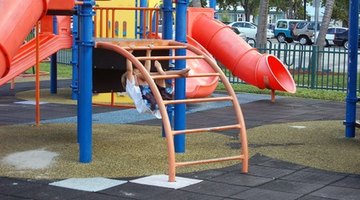How to Install Rubber Pavers on Outdoor Concrete
Rubber pavers are a versatile flooring material used for a large variety of applications. Nonslip, able to be made from recycled materials, lightweight, and virtually maintenance free, rubber pavers can be quickly installed at low cost. You can find rubber pavers on surfaces from playgrounds to sports centers to barn floors. Interlocking rubber pavers are even more versatile to use. Installing interlocking pavers on a concrete surface requires no adhesive, so they’re easy to replace or remove entirely. Just measure the site for the installation, purchase enough pavers to lay down and lock them into place.

Things You Will Need
- Broom
- pH neutral cleanser
- Interlocking pins
- Plywood
- Utility knife
- Rubber-headed mallet
- Cardboard
- Reducer strips
- Polyurethane caulking
Rubber pavers are a versatile flooring material used for a large variety of applications. Nonslip, able to be made from recycled materials, lightweight, and virtually maintenance free, rubber pavers can be quickly installed at low cost. You can find rubber pavers on surfaces from playgrounds to sports centers to barn floors. Interlocking rubber pavers are even more versatile to use. Installing interlocking pavers on a concrete surface requires no adhesive, so they’re easy to replace or remove entirely. Just measure the site for the installation, purchase enough pavers to lay down and lock them into place.
-
Place the rubber pavers in small piles surrounding the installation area at least 24 hours prior to paver installation in order to acclimatize to local conditions. This should make the pavers easier to access as you go along and prevent last minute shrinkage or expansion of the pavers after placement.
-
Clean the concrete subsurface completely, removing any dirt or debris by sweeping the slab and then using a pH neutral cleanser on the surface to remove dirt residue. Make certain the slab is completely dry before installing the pavers. If installing on newly poured concrete, wait 28 days at a minimum between finishing the pour and installation to allow for complete curing of the concrete.
-
Install the pavers beginning at a corner of the concrete slab or against a wall or building. Align the interlocking pavers with the interlocking holes turned toward the uncovered portion of the slab. Place a single complete line of pavers for the first row.
-
Cut a full paver in half and then use the half paver to start the second row butting against the first row of pavers. Place the interlocking pins in the interlocking holes in the first row of pavers and then slip the second row of pavers onto the pins, securing them into place. Tap the second pavers at the edge with a rubber-headed mallet if necessary to press the pavers tightly against one another. Build each row of pavers staggered against the prior row so that the joints are nonaligned to add strength to the installed surface.
-
Cut rubber pavers by placing the paver onto a piece of plywood. Place a straightedge along the line to be cut and, using a utility knife, score a cut along the straightedge. Move the paver so that it overhangs the plywood edge at the cut line and then continue scoring in this cut until you’ve worked the cut through the entire paver. As you cut, the paver will sag along the line off the edge of the plywood, allowing you easier access to the line being cut. Use the same cutting process for curved cuts, only with a cardboard template shaped as needed. Curved cuts may be required if paving over a vent, pipe or other obstruction.
-
Place the reducer strips along the edges of the pavers. The reducer strips act as safety ramps between the surfaces surrounding the pavers and the slightly higher pavers, reducing tripping hazards. Attach the reducer strips using a nonsolvent based adhesive, tapping them solidly into place with the rubber mallet.
-
Fill any gaps between pipes or obstructions and the rubber pavers with polyurethane caulking.
References
Writer Bio
Larry Simmons is a freelance writer and expert in the fusion of computer technology and business. He has a B.S. in economics, an M.S. in information systems, an M.S. in communications technology, as well as significant work towards an M.B.A. in finance. He's published several hundred articles with Demand Studios.
Photo Credits
- little boy on a playground ladder image by Wimbledon from Fotolia.com
- little boy on a playground ladder image by Wimbledon from Fotolia.com
More Articles



